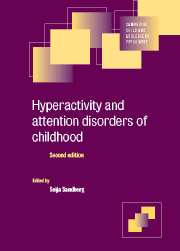Book contents
- Frontmatter
- Contents
- List of contributors
- Preface
- 1 Historical Development
- 2 Epidemiological aspects: what have we learned over the last decade?
- 3 Cross–cultural/ ethnic aspects of childhood hyperactivity
- 4 4 Sex differences and their significance
- 5 Classification issues
- 6 The role of attention
- 7 Cognitive aspects and learning
- 8 Developmental perspectives
- 9 Behavioural and molecular genetic studies
- 10 Biological underpinnings of ADHD
- 11 Psychosocial contributions
- 12 Institutional care as a risk factor for inattention/overactivity
- 13 Treatments: The case of the MTA study
- 14 Attention feficit hyperactivity disorder in adults
- Index
5 - Classification issues
Published online by Cambridge University Press: 28 August 2009
- Frontmatter
- Contents
- List of contributors
- Preface
- 1 Historical Development
- 2 Epidemiological aspects: what have we learned over the last decade?
- 3 Cross–cultural/ ethnic aspects of childhood hyperactivity
- 4 4 Sex differences and their significance
- 5 Classification issues
- 6 The role of attention
- 7 Cognitive aspects and learning
- 8 Developmental perspectives
- 9 Behavioural and molecular genetic studies
- 10 Biological underpinnings of ADHD
- 11 Psychosocial contributions
- 12 Institutional care as a risk factor for inattention/overactivity
- 13 Treatments: The case of the MTA study
- 14 Attention feficit hyperactivity disorder in adults
- Index
Summary
Restlessness, inattention and impulsiveness are common behaviours, especially among preschool and school-age children. Adolescents and adults exhibit these traits as well but usually to a lesser extent. In the extreme, these behaviours are impairing to affected individuals and disturbing to those around them. Consequently, they are thought to define a mental disorder. The very existence of this disorder, the criteria used for diagnosis and the diagnostic label applied to it have been debated extensively. Various terms have been used to describe the syndrome of developmentally abnormal and impairing hyperactive, inattentive and impulsive behaviour. In the two most widely and currently applied diagnostic schemata in clinical child psychiatry, the Diagnostic and Statistical Manual of the American Psychiatric Association (DSM-IV; American Psychiatric Association, 1994), used primarily in North America, and the International Classification of Disease (ICD-10; World Health Organization, 1992), used primarily in Europe, the syndrome is known as attention deficit hyperactivity disorder (ADHD) and hyperkinetic disorder (HD) respectively. In this chapter, we review the evolution and scientific foundation of this category of mental illness. Typically, the classification of psychopathology is a somewhat arcane matter of concern only to practitioners and nosologists. That is certainly not the case with hyperactivity where the diagnosis is widely discussed in the media and the lay press. It is often asserted that hyperactivity is overdiagnosed, particularly in North America.
- Type
- Chapter
- Information
- Hyperactivity and Attention Disorders of Childhood , pp. 126 - 161Publisher: Cambridge University PressPrint publication year: 2002

